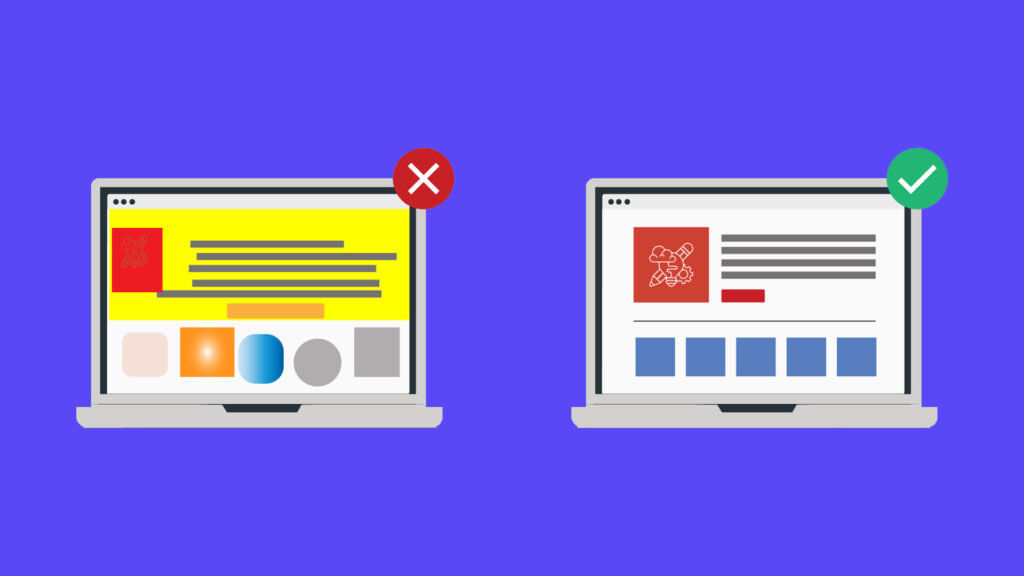A well-designed website is essential for any business or individual seeking to establish a strong online presence. However, creating an effective website requires more than just throwing together some images and text. There are numerous pitfalls that can hinder the success of a website, from poor usability to outdated design trends. To ensure your website stands out and delivers an exceptional user experience, it’s crucial to avoid these common web design mistakes.

Ignoring Mobile Responsiveness
Picture this: you’re on your phone trying to check out a cool website, but instead you’re squinting and pinching your screen like you’re playing an intense game of digital whack-a-mole.
With the majority of internet users now accessing websites through mobile devices, ensuring your website is mobile-responsive is non-negotiable. Failing to optimize your site for various screen sizes and devices will result in a poor user experience and could lead to high bounce rates.
Invest in responsive design to ensure your website looks and functions seamlessly across all devices.
Overcomplicating Navigation
Ever wandered into a website’s navigation menu and felt like you stumbled into a labyrinth? Yeah, we’ve all been there. Nobody wants to play hide-and-seek with your content.
Clear and intuitive navigation is vital for guiding users through your website and helping them find the information they need quickly. Avoid overcomplicating navigation menus with too many options or obscure labels.
Keep it simple, organized, and ensure that visitors can easily navigate to any section of your site within a few clicks.
Cluttered Design
A cluttered website overwhelms visitors and makes it difficult for them to focus on essential content. Avoid cramming too much information onto a single page and prioritize clean, minimalist design principles.
Use ample white space to allow content to breathe, and declutter your design by removing any unnecessary elements that distract from your core message.

Poor Readability
No matter how visually appealing your website may be, it’s all for naught if visitors struggle to read the content. Avoid using small fonts, low contrast text, or overly elaborate typography that hinders readability.
Aim for clear, legible fonts and ensure there’s sufficient contrast between text and background colors to enhance readability, especially for users with visual impairments. Or risk sending your visitors on a scavenger hunt for the nearest pair of reading glasses.
Slow Page Load Times
Slow-loading websites are the digital equivalent of watching paint dry – nobody’s got time for that.
In today’s fast-paced digital world, users expect websites to load quickly, and any delays can lead to frustration and abandonment. Avoid heavy images, excessive plugins, and bloated code that slow down your site’s loading speed.
Optimize images, utilize browser caching, and consider using content delivery networks (CDNs) to ensure swift page load times and provide a seamless browsing experience. You don’t want to send your visitors into a digital coma.
Lack of Call-to-Action (CTA)
Want your visitors to actually do something on your site? Then stop playing hard to get and give them a clear call-to-action.
A website without clear calls-to-action fails to guide visitors towards desired actions, whether it’s making a purchase, signing up for a newsletter, or contacting the business. Ensure your website incorporates prominent and compelling CTAs throughout, prompting users to take the next step.
Make CTAs visually distinct, concise, and strategically placed to maximize conversions.

Inconsistent Branding
Have you ever been scrolling through a website and suddenly it’s like you’ve entered a parallel universe? One where the color scheme is all over the place and the logo drastically changes from page to page?
Consistency is key to building a strong brand identity, and your website should reflect this across all elements, including colors, fonts, imagery, and messaging. Avoid using conflicting styles or deviating from your brand guidelines, as this can confuse visitors and dilute your brand’s impact.
Maintain a cohesive visual identity throughout your website to reinforce brand recognition and trust.
Lack of Visual Hierarchy
Visual hierarchy is crucial for guiding users’ attention and emphasizing the most important elements on a web page. Without clear hierarchy, visitors may struggle to prioritize information or navigate through your content effectively.
Use size, color, typography, and spacing to establish a clear visual hierarchy, ensuring that essential elements stand out and lead users through the intended flow of information.
Guide your visitors’ eyes like a benevolent puppeteer, and they’ll thank you for it with their undivided attention.
Neglecting SEO Optimization
Your website could be the coolest thing since sliced bread, but if Google can’t find it, it might as well not exist.
Even the most visually stunning website won’t reach its full potential if it’s not optimized for search engines. Neglecting basic SEO practices such as meta tags, proper URL structure, and keyword optimization can result in poor search engine rankings and limited visibility.
Sprinkle those keywords like confetti, optimize those meta tags, and watch your site climb the ranks like a ninja on caffeine.
Failure to Test and Iterate
Congratulations, you’ve launched your website! Time to sit back, relax, and watch the internet fame roll in, right? Nope.
Building a successful website is an ongoing process that requires continuous testing, analysis, and iteration to optimize performance and user experience. Avoid the mistake of launching your website and assuming the work is done.
Instead, gather user feedback, conduct usability tests, analyze website analytics, and make data-driven improvements over time to ensure your website remains relevant, effective, and competitive in the ever-evolving digital landscape.

Conclusion
Creating a successful website requires careful planning, attention to detail, and a focus on delivering an exceptional user experience. By avoiding these common web design mistakes and adhering to best practices, you can ensure your website stands out, engages visitors, and achieves your goals in the digital realm. Remember, your website is often the first impression users have of your brand, so make it count!





